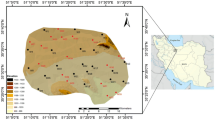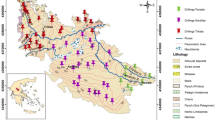Abstract
A multivariate statistical technique was used to determine the major hydrochemical processes that control the groundwater quality variations during “aquifer storage and recovery” (ASR) operations. Principal component analysis (PCA) was applied on chemical and isotopic data of 83 groundwater samples. It has allowed the reduction of the 14 variables to four significant PCs (factors F) that explain 82.2 % of the total variance. F1 (54.1 %) represents the mineralization and groundwater nitrates pollution, whereas F2 (13.2 %) exhibits the isotopic enrichment by evaporation of waters components. Factor score of F1–F2 contains four groups: Injected freshwater (II) distinguished by low mineralization. Native groundwater characterized by relatively high mineralization. Mixing groundwater has intermediate mineralization. The shifting of native groundwater to injected water is related to the mixing ratio between these two components. Thus, the quality of groundwater samples situated close to the injected water is enhanced. Surface water (QF) is enriched by δ18O and δ2H compared to the other components due to evaporation. The spatial pattern of iso-factor scores maps is generally similar to the pattern of EC, Cl−, NO3 −, and mixing ratio maps performed for the same experiment dates. Consequently, under the applied conditions of ASR process, the effective diameter is 250 m and 3 months of recovery time after complete injection. The results of this study clearly demonstrate the usefulness of multivariate statistical analysis as (PCA) in the ASR process investigation.












Similar content being viewed by others
References
Abdi H, Williams LJ (2010) Principal component analysis. WIREs Comp Stat 2:433–459. doi:10.1002/wics.101
Abou Zakhem B, Hafez R (2001) General hydro-isotopic study of direct infiltration and evaporation process through the unsaturated zone in Damascus Oasis, Syria. IAEA-TECDOC-1246, pp 131–170
Abou Zakhem B, Hafez R (2009) Chemical and isotopic study of pollutants transport through unsaturated zone in Damascus Oasis (Syria). IAEA-TECDOC-1618, pp 169–193
Abou Zakhem B, Hafez R (2012) Chemical and isotopic methods for management of artificial recharge in Mazraha Station (Damascus Basin, Syria). Hydrol Process 26:3712–3724
Abou Zakhem B, Hafez R (2015) Hydrochemical, isotopic and statistical characteristics of groundwater nitrate pollution in Damascus Oasis (Syria). Environ Earth Sci. doi:10.1007/s12665-015-4258-1
Adams S, Titus R, Pietersen K, Tredoux G, Harris C (2001) Hydrochemical characteristics of aquifers near Sutherland in the Western Karoo, South Africa. J Hydrol 241:91–103
Al-Charideh A (2012) Recharge rate estimation in the mountain karst aquifer system of Figeh Spring, Syria. Environ Earth Sci 65(4):1169–1178
Al-Tamir MA (2008) Interpretation of ground water quality data variation in Erbil city, Northern Iraq. Al-Rafidain Eng 16(2):24–30
Clark JF, Hudson GB, Davisson ML, Woodside G, Herndon R (2004) Geochemical imaging of flow near an artificial recharge facility, Orange County, California. Ground Water 42(2):167–174
Cloutier V, Lefebvre RR, Therrien M, Savard M (2008) Multivariate statistical analysis of geochemical data as indicative of the hydrogeochemical evolution of groundwater in a sedimentary rock aquifer system. J Hydrol 353:294–313
Davis JC (1973) Statistics and data analysis in geology. Wiley, New York
Davis JC (1986) Statistics and data analysis in geology. Wiley, New York
Dillon P (2005) Future management of aquifer recharge. Hydrogeol J 13:313–316
Dillon P, Herczeg A, Rattray K, Pavelic P, Barry KE (2002) Storage of stormwater in aquifers via injection wells—evaluation of fate and subsurface processes using geochemical and isotopic tracers. IHP-IAH Workshop on Evaluation of Recharge Enhancement Projects in Arid and Semi-arid Areas, 21–22 September 2002
Dillon P, Pavelic P, Tozea T, Rinck-Pfeiffer S, Martin R, Knapton A, Pidsley D (2006) Role of aquifer storage in water reuse. Desalination 188:123–134
Epstein S, Mayeda TK (1953) Variations of the 18O/16O ratio in natural waters. Geochim Cosmochim Acta 4:213–224
Gal I, Neumann R, Calow R, Moench M (2002) The effectiveness of artificial recharge of groundwater: a review. British Geological Survey, commercial report CR/02/108 N, Keyworth, Nottingham
Guillaume P, Xanthoulis D (1996) Irrigation of vegetable crops as a means of recycling wastewater: applied to Hesbaye Frost. Water Sci Technol 33:317–326
Hamzaoui-Azaza F, Bouhlila R, Gueddari M (2009) Geochemistry of fluoride and major ion in the groundwater samples of triassic aquifer (South Eastern Tunisia), through multivariate and hydrochemical techniques. J Appl Sci Res 5(11):1941–1951
Helena B, Pardo R, Vega M, Barrado E, Fernandez JM, Fernandez L (2000) Temporal evolution of ground water composition in an alluvial aquifer (Pisuerga River, Spain) by principal component analysis. Water Res 34:807–816
Herczeg AL, Edmunds WM (2000) Inorganic ions as tracers. In: Cook PG, Herczeg AL (eds) Environmental tracers in subsurface hydrology. Kluwer Academic Publishers, Boston, pp 31–77
Herczeg AL, Rattray KJ, Dillon PJ, Pavelic P, Barry KE (2004) Mineral–solution interactions during 5 years of aquifer storage and recovery in a confined carbonate aquifer. Ground Water 42(3):438–445
Homsi M, Bouni M, Kurdi A (1989) Damascus basin climate and its role in economical plans and the climatic changes. National Meteorology report, p 35
Iyer CS, Sindhu M, Kulkarni SG, Tambe SS, Kulkarni BD (2003) Statistical analysis of the physico-chemical data on the coastal waters of Cochin. J Environ Monit 5:324–327
Jackson JE (1991) A user’s guide to principal components. Wiley, New York
Kleinbaum DG, Kupper LL, Muller KE (1988) Applied regression analysis and other multivariable methods, 2nd edn. PWS-KENT Publishing, Boston, p 718
Le Gal La Salle C, Vanderzalm J, Hutson J, Dillon P, Pavelic P, Martin R (2005) Isotope evolution and contribution to geochemical investigations in aquifer storage and recovery: a case study using reclaimed water at Bolivar, South Australia. Hydrol Process 19:3395–3411
Ma L, Spalding RF (1996) Stable isotope characterization of the impacts of artificial ground water recharge. Water Resour Bull 32(6):1273–1282
Martin-Rosales W, Gisbert J, Pulido-Bosch A, Vallejos A, Fernandez-Cortes A (2007) Estimating groundwater recharge induced by engineering systems in a semiarid area (southeastern Spain). Environ Geol 52:985–995
Meglen RR (1992) Examining large databases: a chemo-metric approach using principal component analysis. Mar Chem 39:217–237
Ministry of Environment (1994) Drinking water quality standards. Higher council for Environment and safety. Damascus, Syria (Arabic)
Muir KS, Coplan TP (1981) Tracing groundwater movement by using the stable isotopes of oxygen and hydrogen, Upper Penitencia Creek alluvial fan, Santa Clara Valley, California. U.S.G.S. Water-Supply, Paper 2075
Mukhopadhyay A, Al-Sulaimi J (1998) Creation of potable water reserve in Kuwait through artificial recharge. In: Peters JH et al (eds) Artificial recharge of ground water. Balkema, Rotterdam, Netherlands, Amsterdam, pp 175–180
Pavelic P, Dillon PJ, Simmons CT (2002) Lumped parameter estimation of initial recovery efficiency during aquifer storage and recovery. In: Dillon PJ (ed) Management of aquifer recharge for sustainability. Proceedings of the 4th international symposium on artificial recharge (ISAR4), Adelaide September 22–26, 2002, Swets & Zeitlinger, Lisse, pp 285–290
Pavelic P, Nicholson BC, Dillon PJ, Barry KE (2005) Fate of disinfection by-products in groundwater during aquifer storage and recovery with reclaimed water. J Contam Hydrol 77:351–373
Ponikarov VP (1966) Explanatory notes on the geological map of Syria, scale 1/200.000, sheet VII (Damascus) “Techno-export”
Pyne RDG (1995) Groundwater recharge and wells: a guide to aquifer storage recovery. Lewis Publishers, Baco Raton
Pyne RDG (1998) Aquifer storage recovery: recent developments in the United States. In: Peters JH (ed) Artificial recharge of groundwater. Proceedings third international symposium on artificial recharge of groundwater—TISAR, Amsterdam 21–25 September, Balkema Publishers, Rotterdam, pp 257–261
Ray C, Melin G, Linsky RB (2002) Riverbank filtration—improving source-water quality. Kluwer Academic Publishers, Dordrecht
Regli C, Rauber M, Huggenberger P (2003) Analysis of aquifer heterogeneity within a well capture zone, comparison of model data with field experiments: a case study from the river Wiese, Switzerland. Aquat Sci 65:111–128
Selkhozpromexport (1986) Water resources use in Barada and Auvage basins for irrigation of crops, volume II, book 2, USSR, Moscow, p 484
Shammas MI (2008) The effectiveness of artificial recharge in combating seawater intrusion in Salalah coastal aquifer, Oman. Environ Geol 55:191–204
Soumi G, Chayeb R (1989) Water need and plant irrigation techniques. Rep. UNDP, FAO, SYR/86/015, agriculture ministry, p 33
Stamatis G, Parpodis K, Filintas A, Zagana E (2011) Groundwater quality, nitrate pollution and irrigation environmental management in the Neogene sediments of an agricultural region in central Thessaly (Greece). Environ Earth Sci 64:1081–1105
UN-ESCWA and BGR (2013) (United Nations Economic and Social Commission for Western Asia; Bundesanstalt für Geowissenschaften und Rohstoffe) 2013. Inventory of Shared Water Resources in Western Asia. Beirut
WHO (2004) Guidelines for drinking water quality, Vol. 1 recommendations, 3rd edn. WHO, Geneva
WHO (2008) Guidelines for drinking water quality, Vol. 1 recommendations, 3rd edn. WHO, Geneva
WHO (2011) Guidelines for drinking water quality, Vol. 1 recommendations, 4th edn. WHO, Geneva
Acknowledgments
The author is thankful to Prof. Dr. I. Othman, Director General of Atomic Energy Commission of Syria (AECS), for his encouragement. Thanks to Dr. B. Newman technical officer of the RP, RAS/8/103 (IAEA). The laboratory work performed by the colleagues in Geology Department (AECS) is highly appreciated. This study was carried out under the framework of regional project no RAS/8/103 in cooperation with the International Atomic Energy Agency (IAEA) entitled: “The use of isotopes and geochemical techniques in the study of artificial recharge”. The author would like to thank the Editor Prof. James W. LaMoreaux and reviewers for their constructive and valuable comments.
Author information
Authors and Affiliations
Corresponding author
Rights and permissions
About this article
Cite this article
Abou Zakhem, B. Using principal component analysis (PCA) in the investigation of aquifer storage and recovery (ASR) in Damascus Basin (Syria). Environ Earth Sci 75, 1123 (2016). https://doi.org/10.1007/s12665-016-5923-8
Received:
Accepted:
Published:
DOI: https://doi.org/10.1007/s12665-016-5923-8




